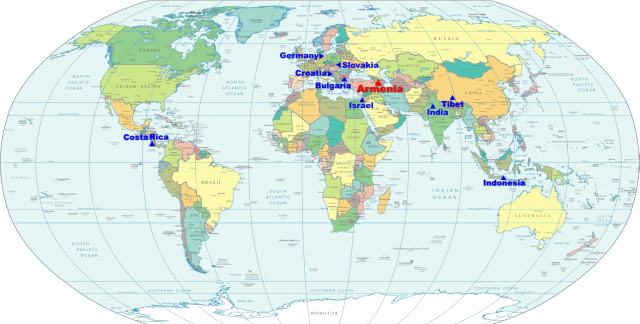 Space Environment Viewing and Analysis Network (SEVAN) Space Environment Viewing and Analysis Network (SEVAN)
PIs: Ashot Chilingarian, Aragats Space Environmental Center, Alikhanian Physics Institute, Armenia
SEVAN (Space Environmental Viewing and Analysis Network) is a network of particle detectors located at middle and low latitudes which aims to improve fundamental research of space weather conditions and to provide short and long-term forecasts of dangerous consequences of space storms.
The network will detect changing fluxes of different species of secondary cosmic rays at different altitudes and latitudes, thus turning into a powerful integrated device used to explore solar modulation effects.
To facilitate SEVAN network creation, CRD will design and develop the basic hybrid SEVAN particle detector module and assume responsibility for all electronics and advanced data acquisition system (ADAS). CRD will also fabricate and test the SEVAN prototype module, as well as provide free scintillator slabs and photomultipliers to be installed at the host institutions.
The host institutions, in turn, will have to provide steel frame of the detector, lead filter and scintillator housing.They will also be responsible for transporting scintillator slabs from Armenia and for providing SEVAN detectors with uninterruptible internet connection and electricity.

SEVAN Home Page
|
|
Till to now the SEVAN modules are installed at Aragats Space Environmental Centre in Armenia (3 units at altitudes 800, 2000 and 3200 m a.s.l.), Bulgaria (Moussala) and Croatia (Zagreb), India (New-Dehli univ.) and now under installation in Slovakia (Lomnitsky Schtit).
The main scientific aim is to the improve research of solar particle acceleration in the vicinity of the Sun by detecting highest energy solar cosmic rays giving additional secondaries detected by surface particle detectors and to improve researches of the space environment conditions. Recently SEVAN detectors were used for research of new high-energy phenomena originated in terrestrial atmosphere - Thunderstorm Ground Enhancements (TGEs). In 2011 first joint measurements of solar modulation effects were detected by SEVAN network, now under analysis.
Reference:
- A. Chilingarian and A. Reymers, Investigations of the response of hybrid particle detectors for the Space Environmental Viewing and Analysis Network (SEVAN), Ann. Geophys, 26, (249-257), 2008.

- A. Chilingarian, G. Hovsepyan, K., et al., Space Environmental Viewing and Analysis Network (SEVAN), Earth, Moon and Planets: Vol.104, Issue 1, (195), 2009.
- S. Chilingaryan, A.Chilingarian, V.Danielyan, W.Eppler, Advanced data acquisition system for SEVAN, J. Phys.: Conf. Ser., Volume: 43 Issue: 4, Pages: 717-720, 2009.
- D. Roša, Ch. Angelov, K. Arakelyan, et al., Sevan CRO particle detector for solar physics and space weather research, Cent. Eur. Astrophys. Bull. 34, 115–122, 2010.
- Chilingarian, A.Daryan, K.Arakelyan, et al., Ground-based observations of thunderstorm-correlated fluxes of high-energy electrons, gamma rays, and neutrons, Physical review D., 82, p.043009, 2010.
- Chilingarian, G. Hovsepyan, and A. Hovhannisyan, Particle bursts from thunderclouds: Natural particle accelerators above our heads, Physical review D, 83, p.062001, 2011.
|

